|
|
Transit of MercuryMay 7th, 2003by John Walker |
|
I've wanted to observe a transit of Mercury across the Sun since I was about nine years old, but it wasn't until almost half a century later, on May 7th, 2003, that an opportunity presented itself. Transits of Mercury aren't all that rare—eight previous transits have taken place while I've trod the Earth—but on average half are visible only from the other hemisphere from where one happens to be at the time. Then there are fog, clouds, and the distractions of a life less-than-totally consumed by amateur astronomy to contend with.
So, as transit day grew near, I looked forward to the
upcoming event with great anticipation, since this
time it would occur when the Sun was up, and at a date
and time of day when the probability of clear skies here at
the Unimatrix Zero of
fog and drizzle from which I scan the skies was better than our dismal norm.
 The day before I rather anxiously checked the weather forecast for
the west coast of Switzerland in the
local newspaper, only
to find this polyvalent prognostication which is, notwithstanding its
high probability of correctness, utterly useless in
divining the likelihood of success in the next day's observations.
The day before I rather anxiously checked the weather forecast for
the west coast of Switzerland in the
local newspaper, only
to find this polyvalent prognostication which is, notwithstanding its
high probability of correctness, utterly useless in
divining the likelihood of success in the next day's observations.
Being, as all who know me will testify, an eternal optimist, not to mention about as spontaneous as a dripping faucet, I spent much of the evening of the sixth of May setting up and testing the telescope and associated optics, solar filter, and camera I hoped to use to observe and record the event should the rain and cloud gods happen to sleep in the following morning.
Unlike my photography of the solar eclipses of
1999 and
2001, which
employed a vintage film camera, this time just call me
Mr. Digital. To observe the Sun, I used
my trusty Brandon 80 mm apochromatic refractor
fitted with an
Orion
full aperture coated glass solar filter. The telescope was
mounted on a simple wooden tripod and altazimuth non-driven
mount with mechanical slow motions. For photography, I relied upon
the same Olympus
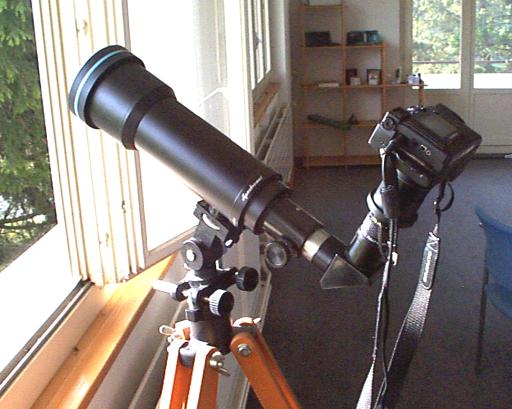 C-3040 digital camera I used for
non-astronomical photography
on the
2001 eclipse expedition.
The digital camera was attached to the telescope with a
ScopeTronix
Digi-T adaptor, which couples a variety of digital cameras
to many popular 1¼ inch eyepieces. I use the ScopeTronix ST
series Plössl eyepieces with this adaptor. The
25, 15, 9, and 6 mm focal length eyepieces were used in taking the
photos below, with most of the full-Sun shots made with the
15 mm.
C-3040 digital camera I used for
non-astronomical photography
on the
2001 eclipse expedition.
The digital camera was attached to the telescope with a
ScopeTronix
Digi-T adaptor, which couples a variety of digital cameras
to many popular 1¼ inch eyepieces. I use the ScopeTronix ST
series Plössl eyepieces with this adaptor. The
25, 15, 9, and 6 mm focal length eyepieces were used in taking the
photos below, with most of the full-Sun shots made with the
15 mm.
Unlike most telescope adaptors for film cameras, the Digi-T adaptor couples the telescope and eyepiece to the existing optics of the digital camera. While cranking heaven knows how many additional optical surfaces and all the compromises inherent in any zoom lens into the optical path has its downside, there are a number of excellent reasons for this, principal among them that most affordable digital cameras don't have removable lenses! Once you're resigned to imaging through the camera's lens, there are compensations. The zoom capability, for example, gives you an effective focal length for a given eyepiece which is variable over the optical zoom factor of the camera (3× for the Olympus camera I used). The normally useless “digital zoom” facility (an image scaling operation providing no additional resolution) even comes in handy since, although you'd never want to make an exposure with it, it does allow you to blow up the image on the grotesquely coarse (for astronomical imaging) LCD viewfinder to a scale which permits the fine focusing astrophotography demands.
I mounted the camera to the telescope on a “star diagonal” for several reasons. First of all, I wanted to be able to quickly swap between the camera and an eyepiece for visual observation (as I have no other telescope equipped with a solar filter). Given the altitude of the Sun in the sky during the transit, it was much more comfortable to visually observe using the diagonal (plus, it keeps the direct Sun out of your face while observing). Second, mounting the camera on the diagonal also minimised the re-focusing required when going back and forth between visual observation and photography, and avoided having to shift the notorious drawtube of the Brandon telescope. (The less fiddled-with, the less it's prone to spontaneous trombone improvisations when you least expect it.) Third, with the camera mounted on the diagonal, it was easier to focus and preview images on the LCD viewfinder attached to the camera's back than with the camera mounted coaxially. Finally, and most important of all, the diagonal minimised the extent the telescope's centre of gravity shifted aft of its tripod socket with the camera attached. The somewhat tacky mount on the tripod I used is prone to slippage or sloppy altitude slow motion behaviour when confronted with out-of-trim cargo.
Having experimented by shooting sunspots on the occasional clear day in the run-up to the transit, I developed the following guidelines for solar photography with this lash-up. First and foremost is the absolute imperative for any solar observation: make absolutely, positively certain the solar filter is mounted on the telescope before aiming it anywhere near the Sun. The Orion solar filter has a very nice blue band around it to help you confirm it's in place from the eyepiece end of the telescope, but I wouldn't remotely consider putting my eye, or an expensive digital camera, anywhere near a telescope without first verifying, from the objective end, that the filter was securely fastened in place. Second, if your telescope has a finder scope, be sure there's a lenscap firmly fastened on its objective (sunward lens) and/or aluminium foil affixed over it. It is not only distracting but painful and potentially dangerous to discover, whilst regarding the Sun through the main 'scope, that your hair has been set afire (or, in my case, scalp singed) by sunlight focused through the finder.
Since the last thing one needs during any photo shoot is for the batteries to die, I planned to use the AC adaptor for all photography. The position of the Sun in the sky during the transit would be such that the entire event could be observed from an open window in the Fourmilab conference room and the balcony outside it, so an extension cord sufficed to supply mains power to the camera.
For the Olympus camera, I settled on the following settings. I first placed the camera in “Program” (P) mode, and selected Macro mode, manual focus, setting the focus to infinity, and remote shutter release using the infrared remote control with which this camera is equipped. I then switched to A/S/M manual exposure mode (for some reason, my camera doesn't permit you to select Macro focusing while in this mode, but remains in Macro when switched to it from P). The aperture should be set to the maximum available: f/1.8 to f/2.6 depending upon the zoom; usually you try to stop down a lens as far as possible to improve image quality, but with the weird optical pipeline here, stopping down the camera's lens causes severe vignetting of the image, so it's best to select full aperture.
With the camera set to manual focus, the telescope's focuser is
used to obtain a sharp focus. The LCD viewfinder, set to
“always on” display (not a problem when running from mains
power), is used to confirm focus. When focusing on the Sun, I
found it best to use the edge of the Sun for coarse focus when
zoomed out, then zoom in for fine focus, using the digital zoom
range to blow up sunspots to obtain the sharpest focus.
Remember to zoom out of the digital zoom range before taking
any pictures. Usually, it's best to lock out the digital zoom,
but doing so forfeits the ability to use
it for fine focusing unless you're willing to waste lots of
time fiddling with menus every time you focus. I made all
exposures with the remote control—this avoids vibration
induced by pressing the shutter release on the camera.
With everything at the ready, there was nothing to do but await the morning of the 7th (the transit would begin at 07:11 local time) and see what there was to see. The sky that morning was far from promising—in fact, it was barely one notch better than clouded out. Shortly after sunrise, it was difficult to discern the Sun's disc with the unaided eye; a noxious mix of haze, light stratus clouds, and general atmospheric gunk rendered the eastern sky almost uniformly bright within about 30° of the Sun.
Well, we gotta go with the sky we got, so let's get to it. Visual observation through the telescope surprised me with how clearly the Sun's disc was defined. For sure, you could see a boiling mass of turbulent air everywhere, but through the solar filter the solar disc stood out against a black background (since the 99.9% absorption of the filter rejected even the intense scattered light around the Sun). A prominent sunspot group near the centre of the Sun (NOAA active region 0351) was clearly visible, although blurred into a black blob by the awful seeing, rather than exhibiting the structure you'd expect for a sunspot of that size.
I decided to observe the start of the transit visually since I'd never seen one before and wanted to, and also in order to evaluate the prospects for photography. I was very pleased to discover that I could spot the tiny notch in the edge of the Sun shortly after first contact (the moment Mercury's disc impinges upon the Sun), and how beautifully round the disc was as it moved onto the Sun's photosphere, so obviously darker than the central sunspot. You always hear about how bright sunspots are, but only a transit makes this apparent at a glance.
After Mercury had moved onto the disc of the Sun, I undertook the photography presented in the following gallery. I didn't adhere to a rigid program for the photographs—I experimented, alternated between visual observation and photography, and paused to download pictures to my computer and analyse them to evaluate the results so far. I'm an amateur astronomer—I do this for fun, and the last thing I need is a dour data-taking mentality instead of enjoying a celestial spectacle I've dreamed of seeing since I was a little kid.
| Event | Time (UTC) |
Position Angle |
|---|---|---|
| Contact I | 05:12:56 | 15° |
| Contact II | 05:17:24 | 14° |
| Mid-transit | 07:52:23 | 333° |
| Contact III | 10:27:19 | 292° |
| Contact IV | 10:31:46 | 291° |
There isn't a tremendous amount to say about the following images so, uncharacteristically, I will be brief. The images are presented in chronological order. All were taken through the Brandon telescope with the Olympus digital camera described above. This optical train flips left and right in the image but doesn't invert it. Consequently, while Mercury appears to traverse the solar disc right to left here, if you'd observed the event with optics which didn't mirror the image, you'd see its path as left to right; I've eschewed image processing in the interest of showing you “what the camera saw”. All of these images are quite close to the visual impression of viewing the transit. In some cases, the photographic images are better, because using a very short exposure time (most of these were taken with shutter speeds between 1/125 and 1/500 second) with lots of exposures permits choosing those rare images captured at moments then the atmosphere was relatively calm. That said, the seeing throughout this entire event was horrific, and the quality of these images is not at all representative of what these optics can deliver when the atmosphere is less hostile to us astronomers who simultaneously breathe and curse it.
Visitors to my other Web pages will be well aware of my disdain for “graphics intense” pages that include numerous large images which take a long time to download, thereby burdening the Internet with downloading them all even if the reader is only interested in a few. Well, for this document move me from the perturbed column to the list of perps, because the following images are all rather large. I originally planned to organise these as a gallery of thumbnails you could click to explore the larger images. Unfortunately, there's a problem: given how fuzzy the seeing was when these images were taken, thumbnails of them completely lose the image of Mercury on the Sun's disc. Well, that doesn't make a lot of sense, so I'm going to inflict the full resolution images on you here, as captured by the CCD sensor in the Olympus camera. All have been cropped from larger original frames. But, apart from cropping, no image processing of any kind has been done.
Here's the first one I shot, immediately after mounting the camera on the telescope after watching the start of the transit. I used the 25 mm eyepiece for this one with the lens on the camera zoomed all the way out. The atmosphere was yuck city—you can see a light cloud obscuring the disc of the Sun here; note how the central sunspot is blurred. Still, Mercury is more or less obvious entering the solar disc at around the two o'clock position.
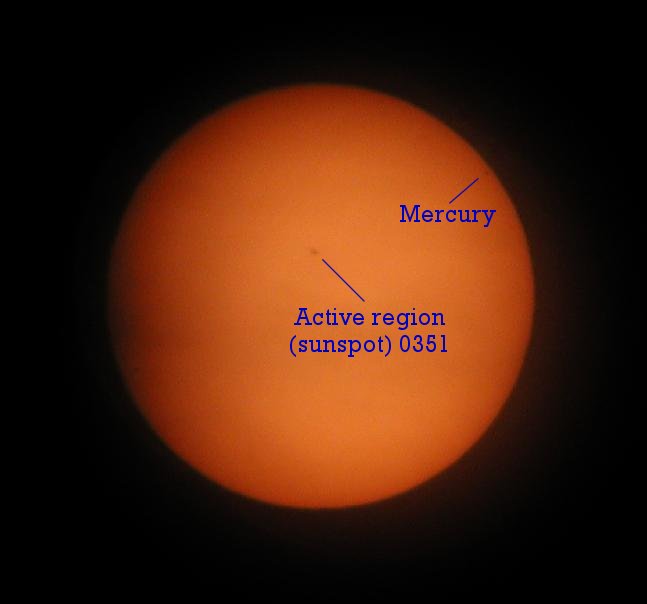
Here's a close-up made by zooming in the Olympus camera lens with the 25 mm eyepiece still attached. Mercury has advanced a bit farther onto the solar disc. The atmosphere remains boiling, and this 1/250 second exposure is substantially clearer than visual observation would suggest.
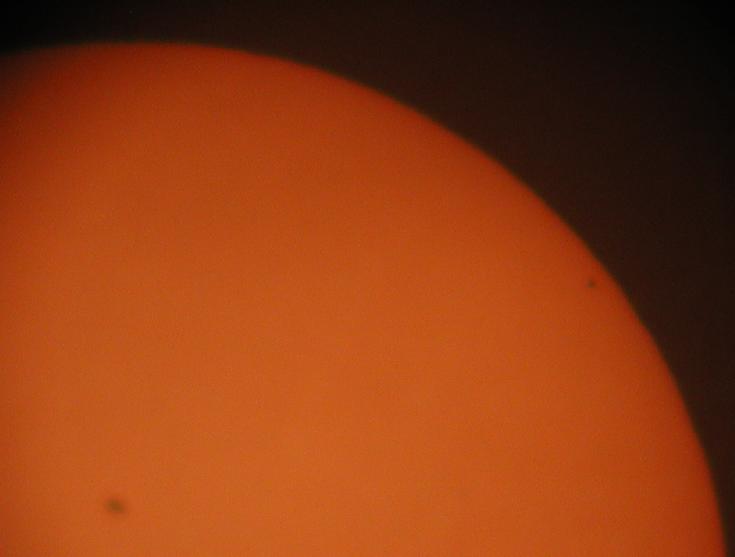
The morning moves on; the Sun rises; and the atmosphere becomes (a tad) less horrible. Note how this image has less of a red cast than the ones before, thanks to reduced scattering by particles in the atmosphere. Mercury is now clearly visible on this full disc shot.

Here's a zoom made not long after the image above. This is one of the first which shows how perfectly circular Mercury's silhouette appears against the Sun's disc, something you never see with sunspots. Also, note how much darker Mercury looks against the Sun than the sunspot at the lower left, Okay, it's subtle: with better seeing, as I spotted on the occasional moment while observing visually, it's more obvious.
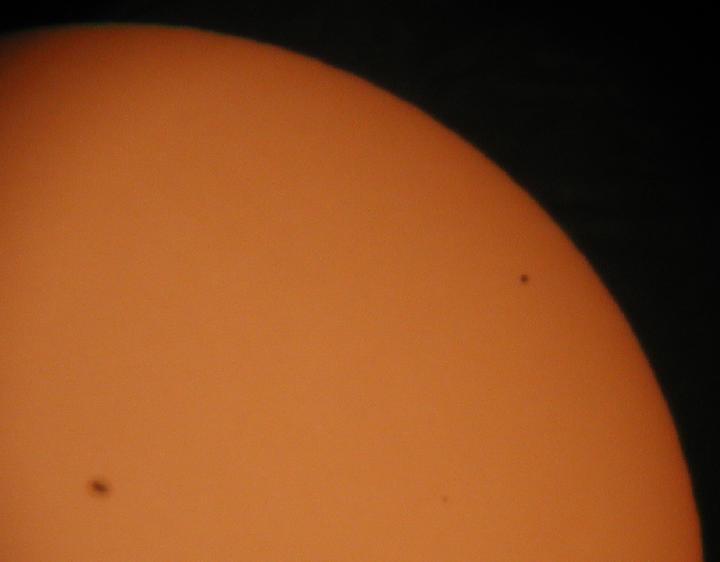
Here we see Mercury progressing across the Sun's disc. Pay no attention to the colour balance of these images. The sun is white—our eyes have evolved to maximise their sensitivity to its illumination. Digital cameras have their own eccentricities regarding “white balance”, and this is apparent in the images here. I could have given them all a uniform hue, but decided it would be more useful for those contemplating their own solar imaging to see what the camera captured for me.
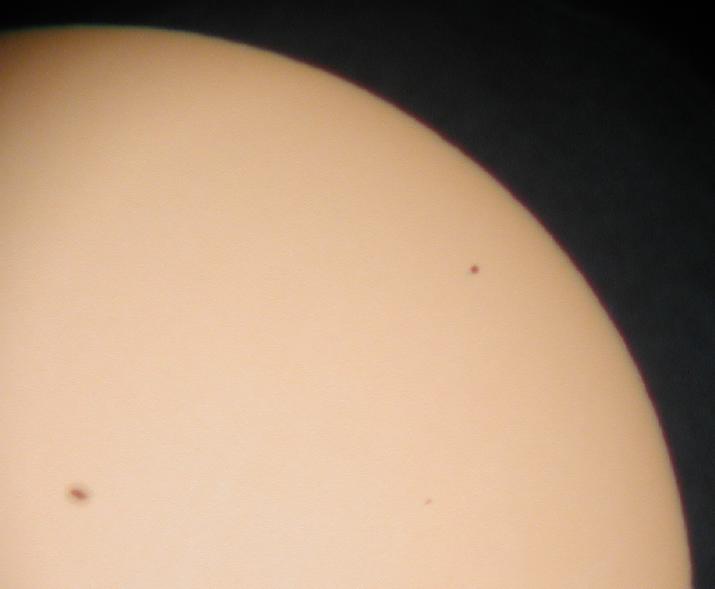
Mercury continues to move across the Sun. This image, the best of the bunch taken around this time, suffers from atmospheric turbulence compared to the one above.

Now we embark on a series of full disc images, all taken with the 15 mm eyepiece, which track the course of Mercury across the Sun. As the Sun rose in the sky, the overall definition improved. Note how much more clearly the sunspots around the 8 o'clock position appear than before.
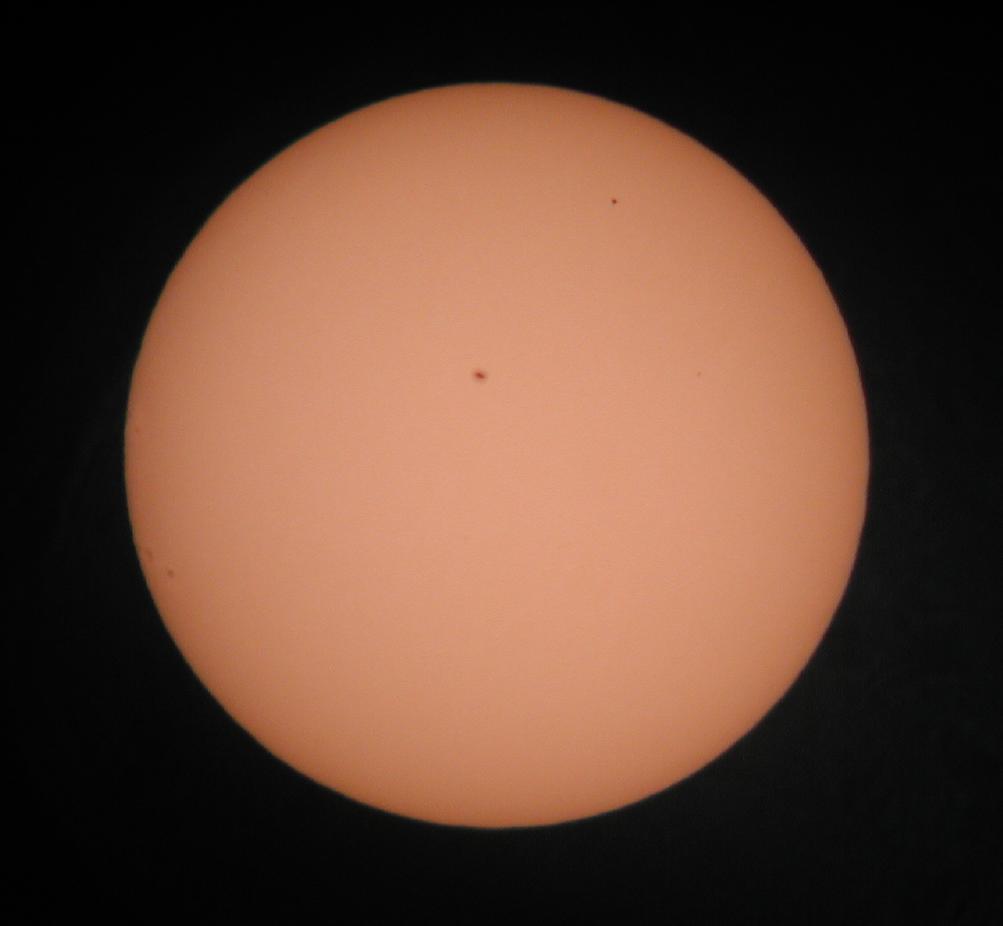
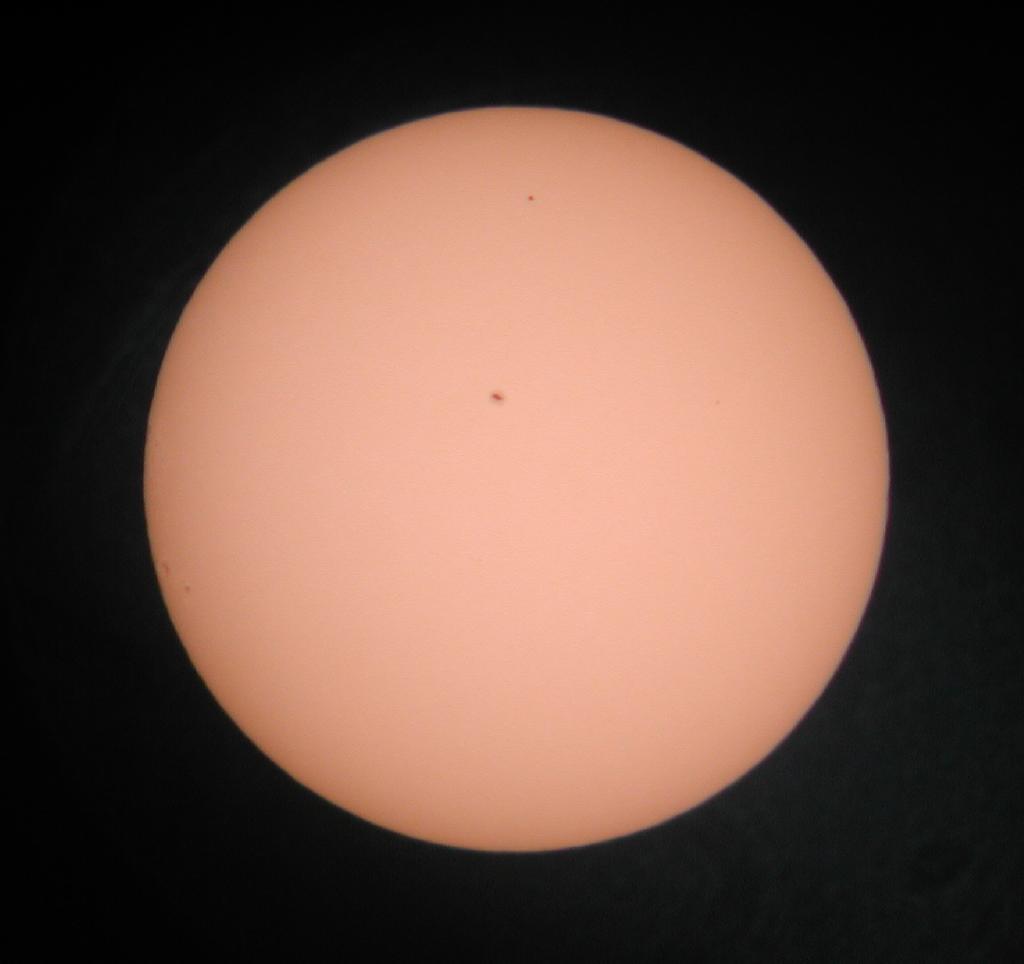
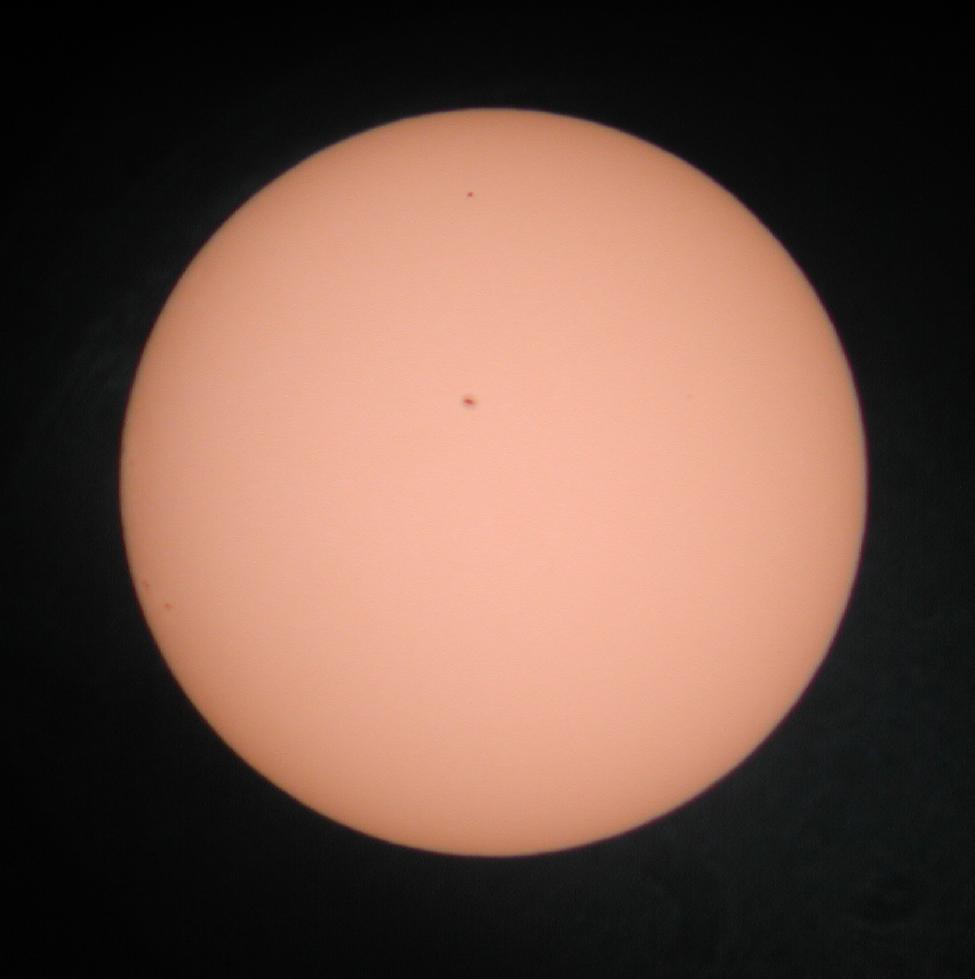
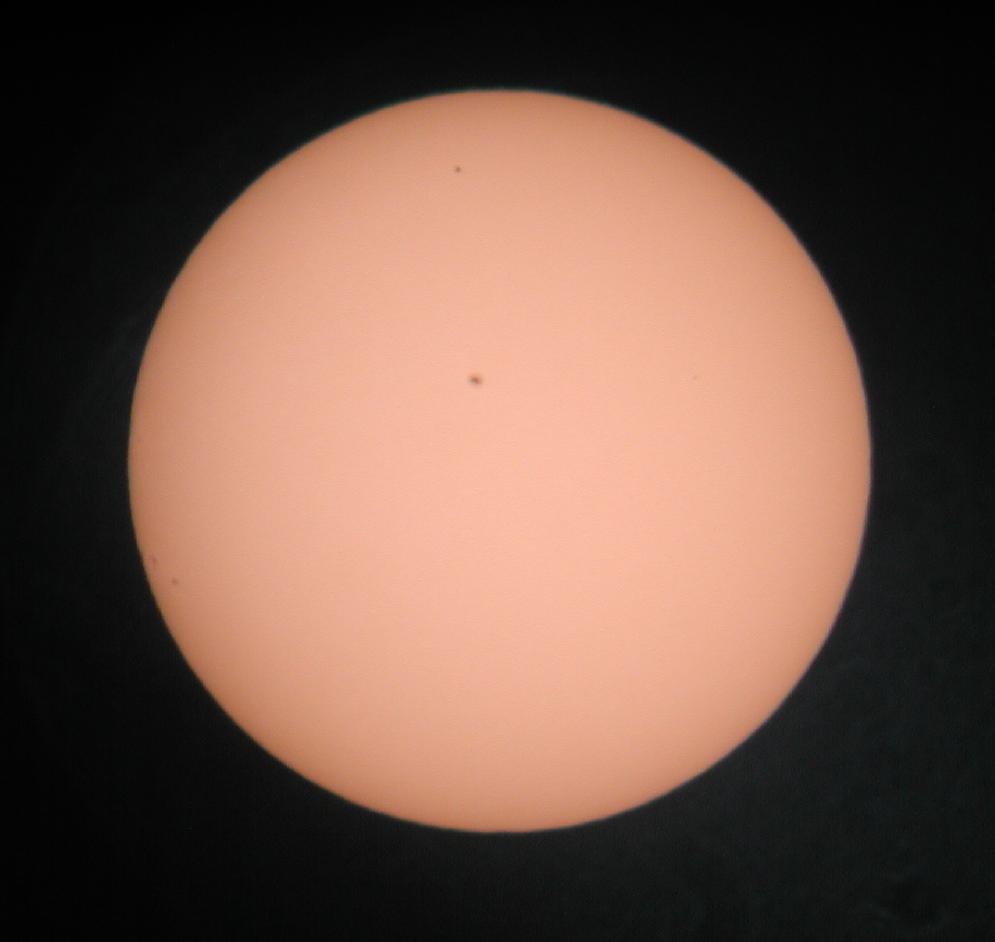

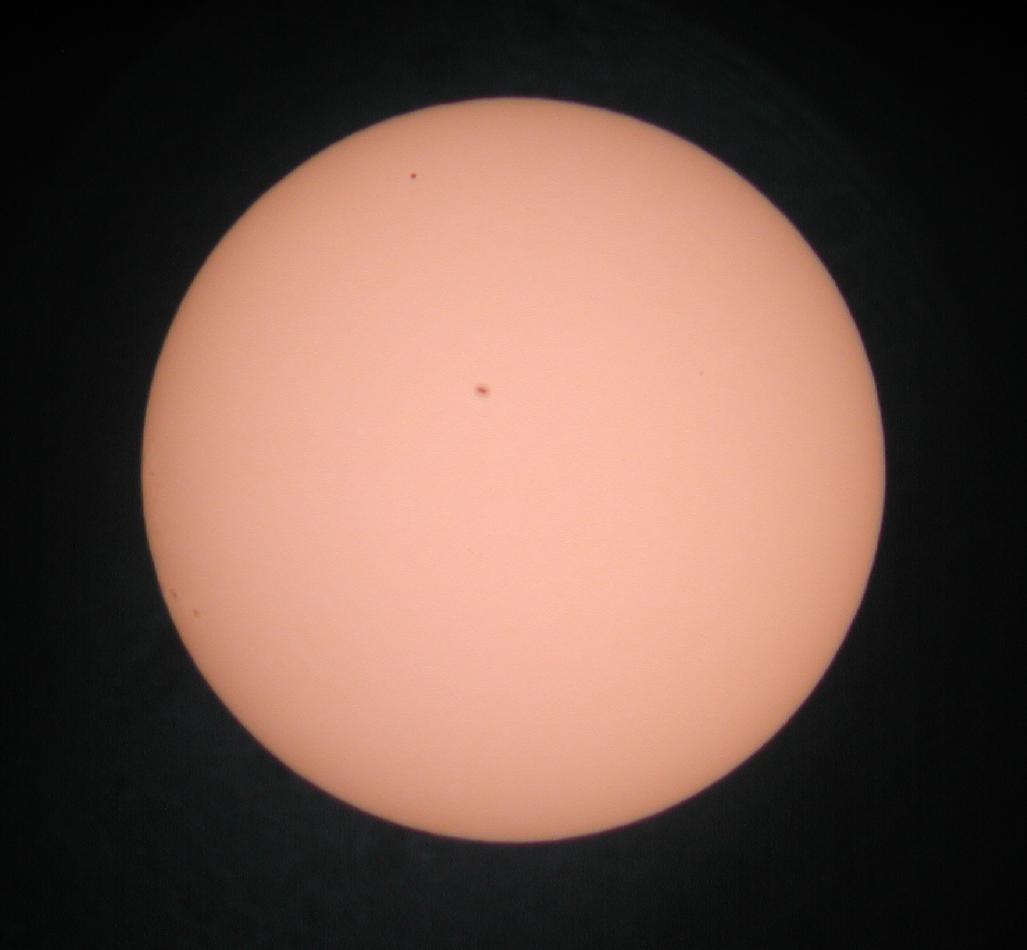
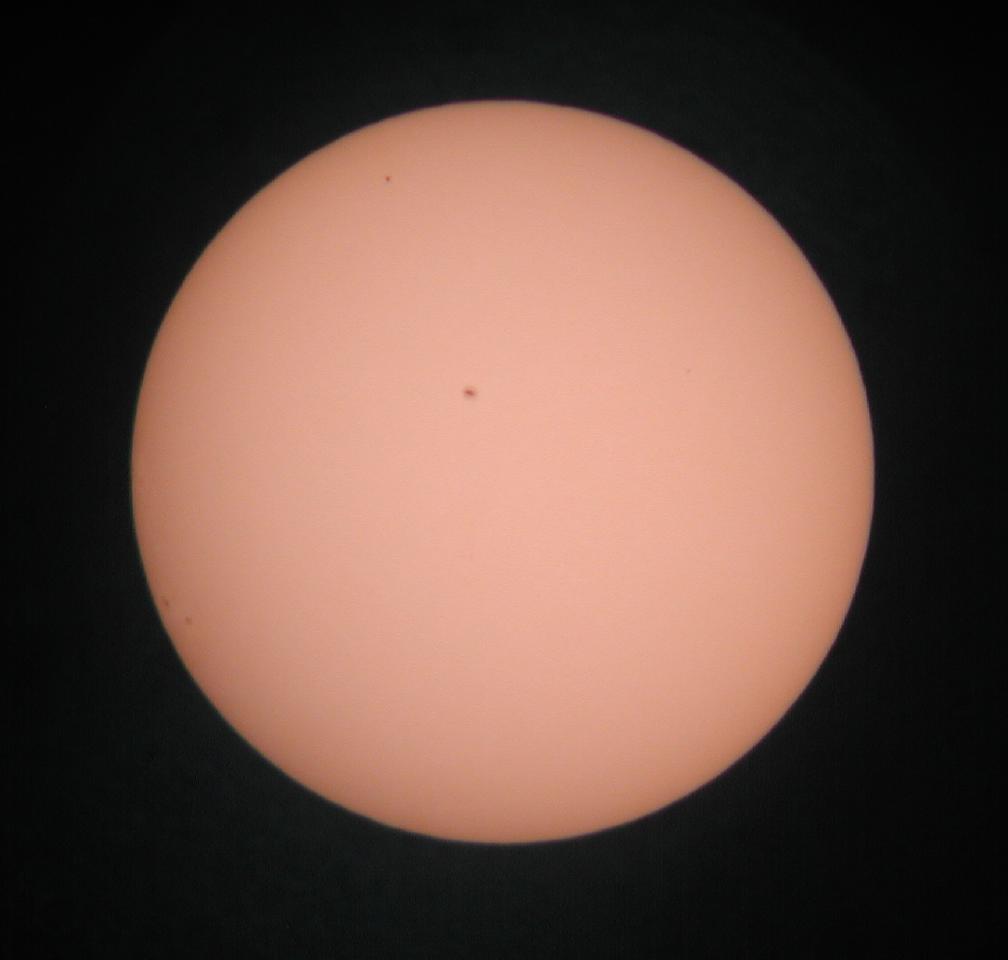
Here's a 9 mm eyepiece closeup of Mercury as it heads for third contact. I shot this picture because I was so impressed with how circular and black Mercury appeared against the solar disc in visual observation at this magnification.
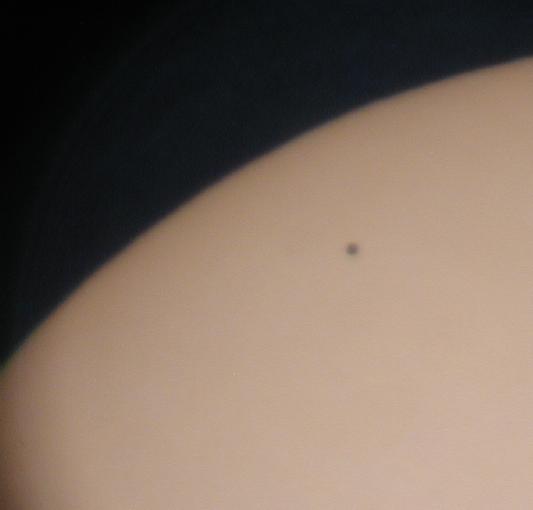
Now we go to a series of full disc views and then zooms which track the approach to third contact and the end of the transit.
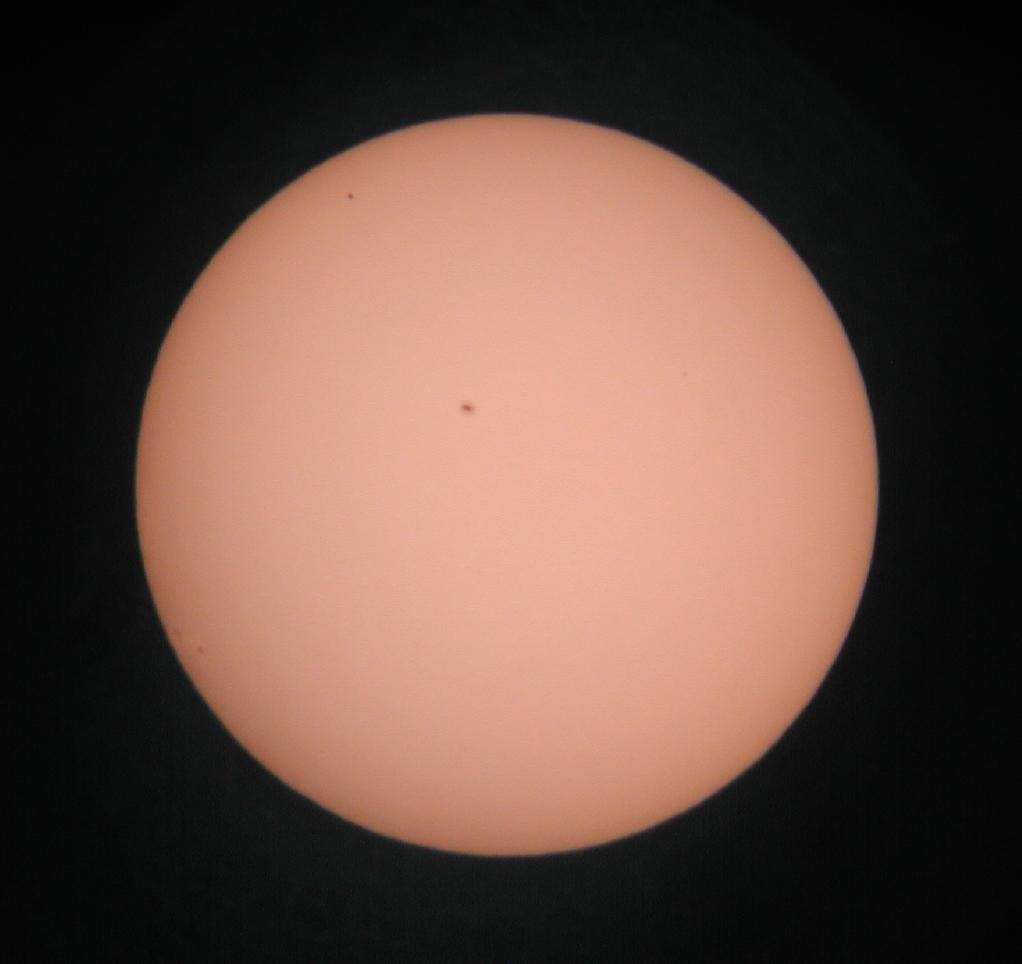

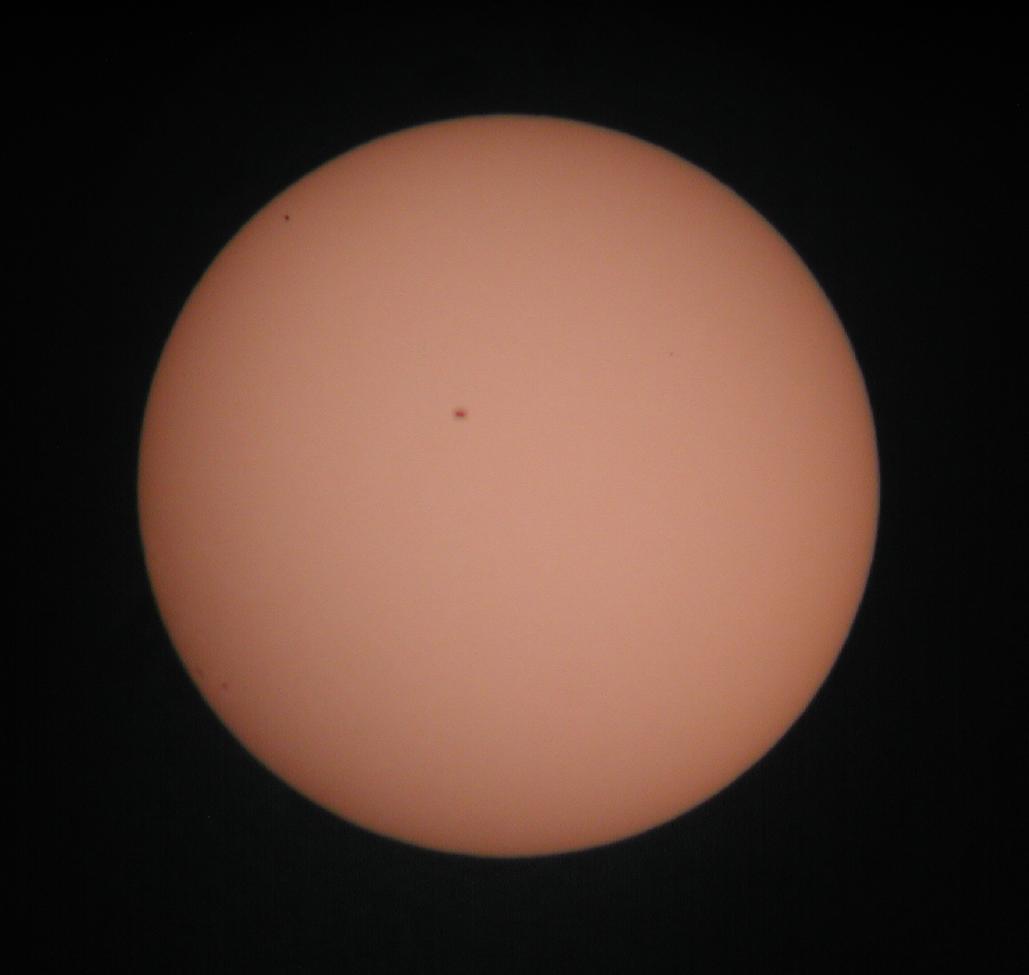
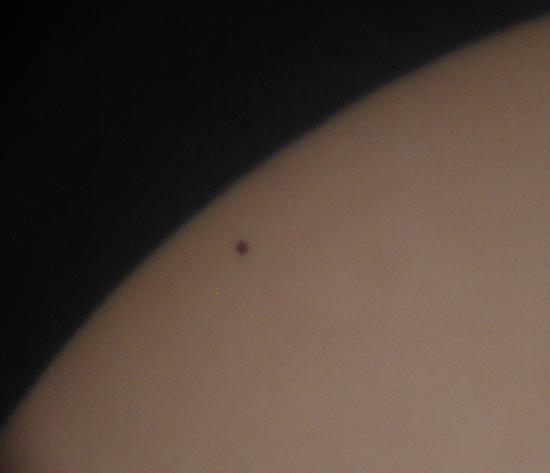
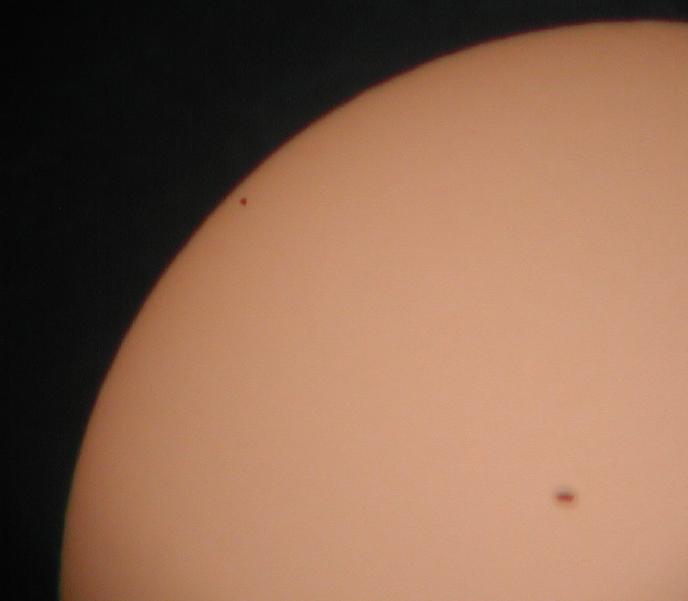
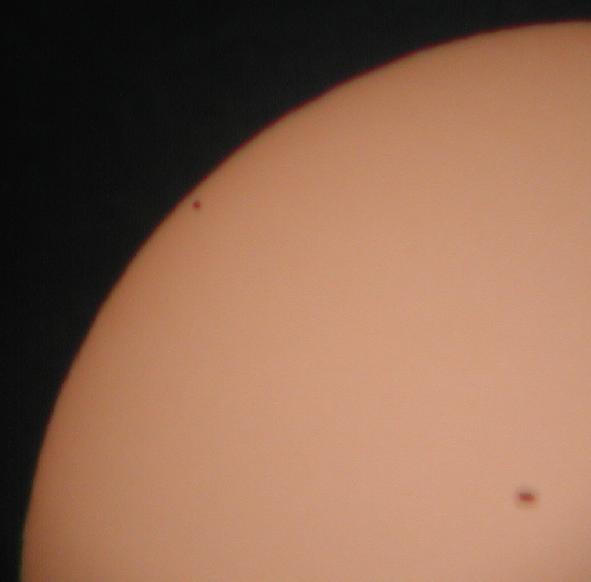
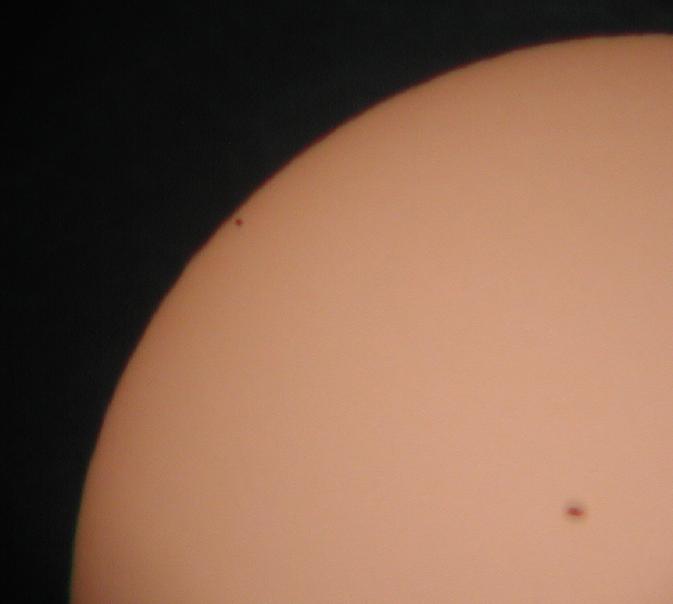
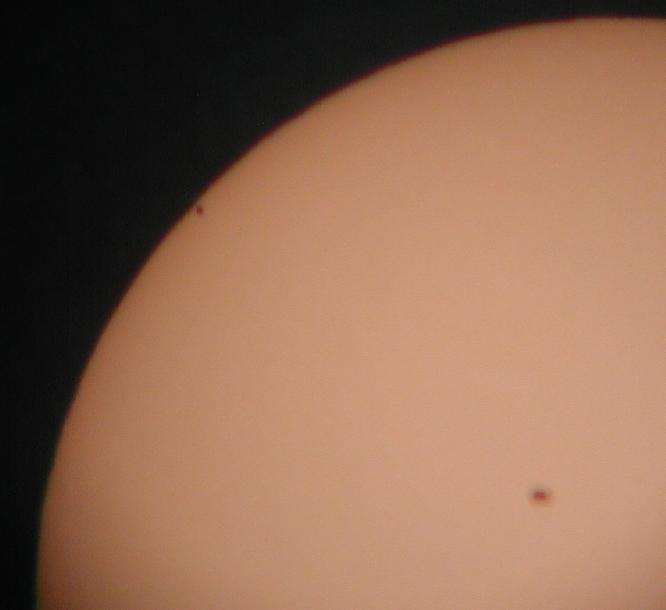
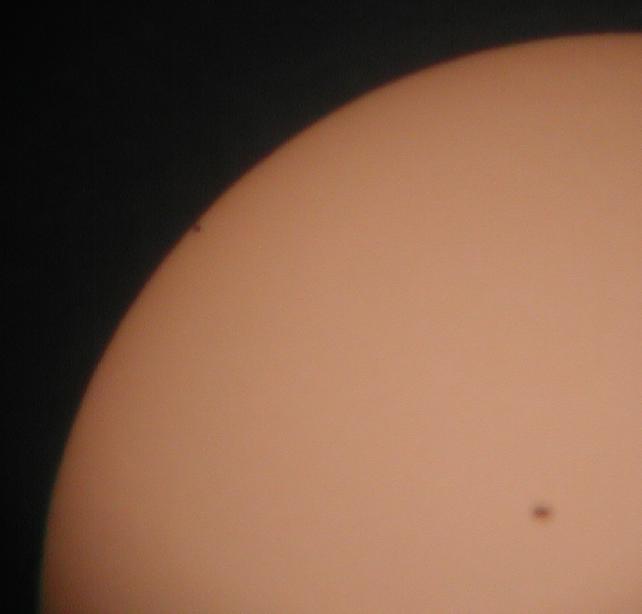
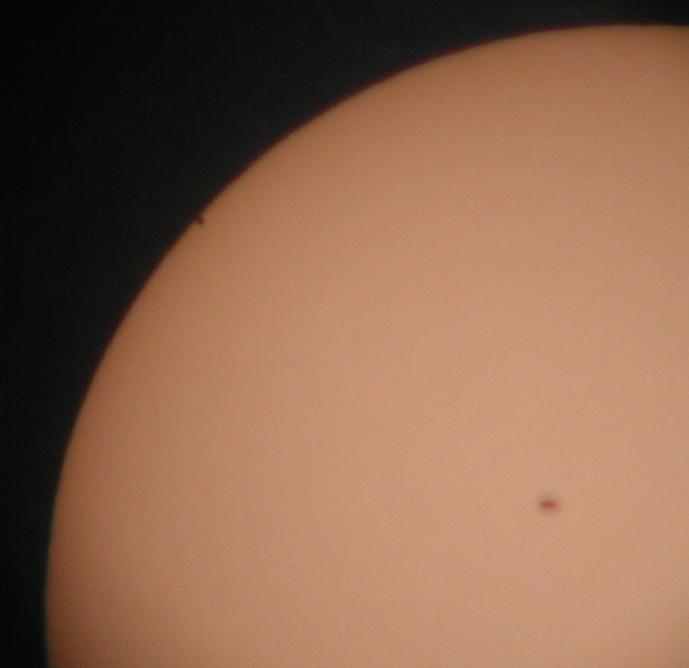
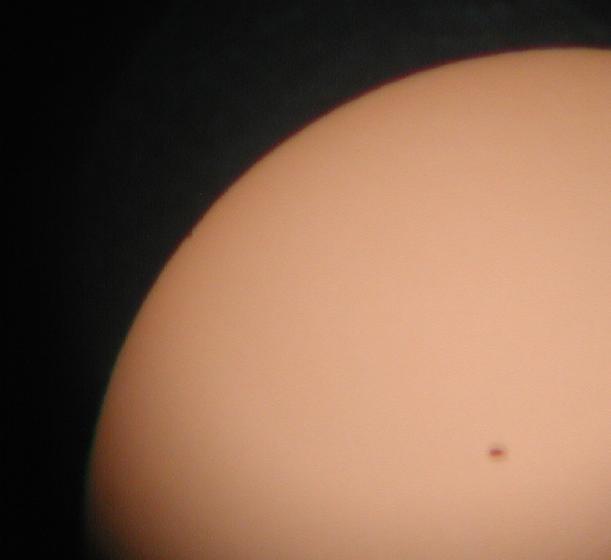
Just a tiny notch remains. Only if you know where to look, based on the earlier images, are you likely to spot it in the image below.
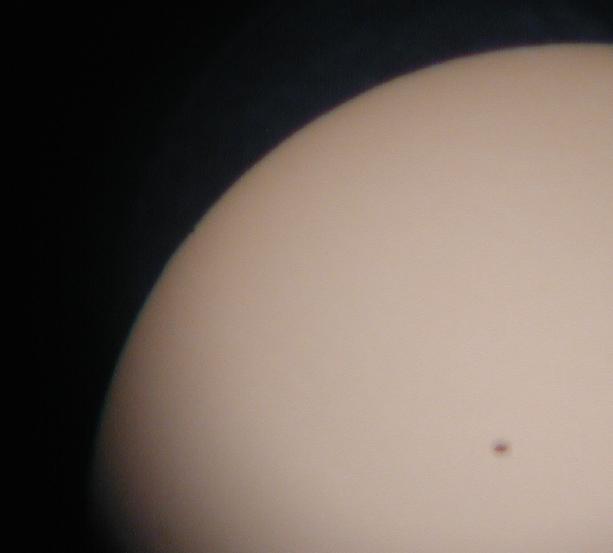
Well, that's it, then. Five and a quarter hours of full-on Big Fun for this amateur astronomer. If you missed this event, I hope these pictures will help you to enjoy it retroactively. If the itch to tickle your retina with such rare phenomena remains, don't despair: the next few years are rich in such events!
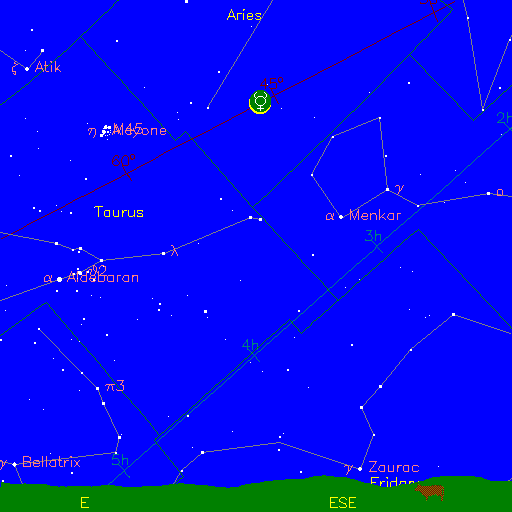 Here's a
Your Sky horizon
view of the sky at mid-transit showing the Sun and
Mercury in the sky looking southward of east. By mid-transit,
the Sun had risen above most of the haze along the horizon, and
one only had to contend with the very thin clouds and the occasional
contrail. Unlike a solar eclipse, almost all transits of
Mercury are visible from the entire hemisphere of Earth where
the Sun is up. Most, but not all…on
November 15, 1999 a grazing transit
of Mercury occurred which was visible only from part of the
illuminated hemisphere of Earth. So rare is such an event that
the last grazing transit before 1999 took place before the
invention of the telescope and the next won't happen until
May 11, 2391—immortals, mark your calendars!
Here's a
Your Sky horizon
view of the sky at mid-transit showing the Sun and
Mercury in the sky looking southward of east. By mid-transit,
the Sun had risen above most of the haze along the horizon, and
one only had to contend with the very thin clouds and the occasional
contrail. Unlike a solar eclipse, almost all transits of
Mercury are visible from the entire hemisphere of Earth where
the Sun is up. Most, but not all…on
November 15, 1999 a grazing transit
of Mercury occurred which was visible only from part of the
illuminated hemisphere of Earth. So rare is such an event that
the last grazing transit before 1999 took place before the
invention of the telescope and the next won't happen until
May 11, 2391—immortals, mark your calendars!
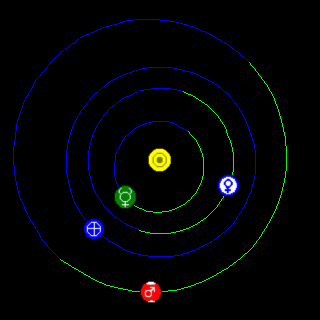 This
Solar System Live
view shows the inner solar system viewed from above the Sun
at mid-transit with orbits drawn to scale. Obviously, the Sun,
Mercury, and the Earth line up—otherwise there wouldn't
be a transit! More interesting is the fact that Mercury is
just at the place in its orbit, the node, where the
plane of its orbit, inclined a little more than 7° with
respect to that of the Earth, intersects the plane of
Earth's orbit, the ecliptic. Since Mercury orbits the Sun
every 88 days, Mercury passes between the Earth and Sun
about every three months, but these inferior conjunctions
result in a transit only if they happen to coincide closely
with where the orbital planes of Earth and Mercury
intersect; otherwise, Mercury passes above or below the Sun
as seen from Earth, and doesn't transit its disc.
This
Solar System Live
view shows the inner solar system viewed from above the Sun
at mid-transit with orbits drawn to scale. Obviously, the Sun,
Mercury, and the Earth line up—otherwise there wouldn't
be a transit! More interesting is the fact that Mercury is
just at the place in its orbit, the node, where the
plane of its orbit, inclined a little more than 7° with
respect to that of the Earth, intersects the plane of
Earth's orbit, the ecliptic. Since Mercury orbits the Sun
every 88 days, Mercury passes between the Earth and Sun
about every three months, but these inferior conjunctions
result in a transit only if they happen to coincide closely
with where the orbital planes of Earth and Mercury
intersect; otherwise, Mercury passes above or below the Sun
as seen from Earth, and doesn't transit its disc.
The necessity for an inferior conjunction closely coinciding with the
time of nodal crossing (indicated in the Orrery view by the
change of the orbital path from blue [above the ecliptic] to
green [below]) in order for a transit to occur is responsible
for the rareness of these events. Transits of Mercury always
occur within a few days of May 8th or November 10th, the moments
where Mercury's and Earth's orbital planes intersect.
| Transits of Mercury: 2000-2100 | ||
|---|---|---|
| Date | Time (UTC) | Separation |
| 2003 May 07 | 07:52 | 708" |
| 2006 Nov 08 | 21:41 | 423" |
| 2016 May 09 | 14:57 | 319" |
| 2019 Nov 11 | 15:20 | 76" |
| 2032 Nov 13 | 08:54 | 572" |
| 2039 Nov 07 | 08:46 | 822" |
| 2049 May 07 | 14:24 | 512" |
| 2052 Nov 09 | 02:30 | 319" |
| 2062 May 10 | 21:37 | 521" |
| 2065 Nov 11 | 20:07 | 181" |
| 2078 Nov 14 | 13:42 | 674" |
| 2085 Nov 07 | 13:36 | 718" |
| 2095 May 08 | 21:08 | 310" |
| 2098 Nov 10 | 07:18 | 215" |
Mercury's orbit is more eccentric than that of any other planet except Pluto (if you deem the latter a planet, as opposed to the first and largest Kuiper belt object discovered to date). The eccentricity of 0.206 is apparent in the Orrery plot. Note that transits which occur in May are near Mercury's aphelion, while those in November (on the other side of the orbit, where the blue/green transition indicates the location of the node) are near its perihelion. At aphelion, Mercury is substantially closer to the Earth and its disc crossing the Sun during a transit is 12 arc seconds in diameter, as opposed to 10 arc seconds at November transits. However, since Mercury moves more slowly near aphelion, May transits occur only every 13 and 33 years, while November transits recur at intervals of 7, 13, and 33 years. The eccentricity of Mercury's orbit and its proximity to the Sun makes it especially sensitive to the subtle differences between Newtonian gravity and general relativity. Explanation of the advance of the perihelion of Mercury's orbit was the first triumph of Einstein's theory of gravitation.
If you missed this transit of Mercury, perhaps you'll be able to
observe one of the coming attractions listed in the table to the left.
The time given is Universal (Greenwich Mean) time at mid-transit.
To determine whether a transit will be visible from your location
(none of the 21st century transits are grazes), simply enter
the date and time into an
Earth and Moon Viewer
map display and see whether the Sun will be above the horizon
at that time. If the Sun's up where you are, you can see the transit.
| Transits of Venus: 1800–2200 | ||
|---|---|---|
| Date | Time (UTC) | Separation |
| 1874 Dec 09 | 04:05 | 832" |
| 1882 Dec 06 | 17:06 | 634" |
| 2004 Jun 08 | 08:19 | 627" |
| 2012 Jun 06 | 01:28 | 553" |
| 2117 Dec 11 | 02:48 | 724" |
| 2125 Dec 08 | 16:01 | 733" |

Transit of Venus, December 6th 1882. Photographed by students at Vassar College: Sky & Telescope, February 1961. |
When it comes to rare celestial events, transits of Mercury are a dime a dozen compared to those of Venus. If you exult in this kind of thing, you're extremely lucky to be alive right here, right now. On June 8th, 2004, Venus will transit the Sun's disc for the first time since December 6th, 1882, one hundred and twenty-two years before. If you observe this transit, you'll be among the only living humans to have seen such an event! A transit of Venus is not only extraordinarily rare, it is a spectacular event, with a very different character than a transit of Mercury. Things happen more slowly—the entire transit takes almost six hours, and it takes a full twenty minutes for the disc of Venus to impinge upon and depart the disc of the Sun. Venus has an atmosphere, so you'll see interesting effects where Venus seems connected to the edge of the Sun like a drop of water about to drip from a faucet. But most of all, the disc of Venus is huge compared to that of Mercury—five times larger than Mercury in a May transit. A transit of Venus is, in fact, as easily visible to the unaided eye (adequately protected for viewing the Sun, of course) as the rare naked eye sunspot.
If you miss the transit of Venus in 2004, perhaps you'll be able to catch the next one in June of 2012. If that doesn't work out, you're in for a bit of a wait, since the next opportunity won't come around until 2117.
Clear skies!
|
|
All images in this document are in the public domain and may be used in any manner without permission, restriction, attribution, or compensation. Back links to Mercury Transit 2003 are welcome.